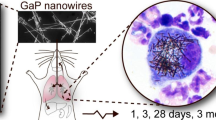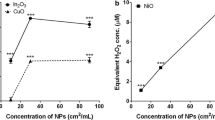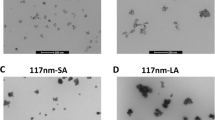Abstract
In this study, we compared their toxicity in vivo and in vitro based on the physicochemical properties of three different types of TiO2 nanowires, H2Ti3O7 nanowires (1HTO), hydrothermal treatment (2HTO), and calcination (3HTO) of 1HTO. The surface of 1HTO was smooth, and the surface of 2HTO was much rougher. The negative charge on the surface increased in the order of 2HTO, 3HTO, and 1HTO, whereas the surface area increased in the order of 3HTO, 1HTO, and 2HTO. The lung is a main exposure route of nanoparticles. On day 28 after a single instillation (1 mg/kg), three nanowires induced a Th2-type inflammatory response together with the relative increase in CD4+ T cells, especially by 2HTO. In vitro, three TiO2 nanowires (10 μg/ml) commonly induced the generation of cell debris in eight cell lines which may be the potential target organ of nanoparticles, especially by 2HTO. It seemed that the generation of cell debris coincides with the increase in autophagosome-like vacuoles in the cytosol. In further study using BEAS-2B cells originated from the lung, the protein amount from cells exposed to 2HTO decreased more clearly although the generation of reactive oxygen species (ROS) was less compared to 1HTO and 3HTO. Based on these results, we suggest that surface area may act as an important factor depends on the biological response by TiO2 nanowires. Furthermore, the increase in autophagosome-like vacuoles may be an important cause of cell death by nanoparticles with ROS.





Similar content being viewed by others
References
Ai J, Biazar E, Jafarpour M, Montazeri M, Majdi A, Aminifard S et al (2011) Nanotoxicology and nanoparticle safety in biomedical designs. Int J Nanomedicine 6:1117–1127
Aillon KL, Xie Y, El-Gendy N, Berkland CJ, Forrest ML (2009) Effects of nanomaterial physicochemical properties on in vivo toxicity. Adv Drug Deliv Rev 61:457–466
Andón FT, Fadeel B. (2012) Programmed Cell Death: Molecular Mechanisms and Implications for Safety Assessment of Nanomaterials. Acc Chem Res Epub ahead of print
Chen X, Mao SS (2007) Titanium dioxide nanomaterials: synthesis, properties, modifications, and applications. Chem Rev 107:2891–2959
Degterev A, Yuan J (2008) Expansion and evolution of cell death programmes. Nat Rev Mol Cell Biol 9(5):378–390
Donaldson K, Tran CL (2004) An introduction to the short-term toxicology of respirable industrial fibres. Mut Res 553:5–9
Donaldson K, Murphy F, Schinwald A, Duffin R, Poland CA (2011) Identifying the pulmonary hazard of high aspect ration nanoparticles to enable their safety-by-design. Nanomedicine (Lond) 6:143–156
Fadeel B, Garcia-Bennett AE (2010) Better safe than sorry: understanding the toxicological properties of inorganic nanoparticles manufactured for biomedical applications. Adv Drug Deliv Rev 62:362–374
Galluzzi L, Kroemer G (2008) Necroptosis: a specialized pathway of programmed necrosis. Cell 135(7):1161–1163
Gustafsson AB, Gottlieb RA (2008) Recycle or die: the role of autophagy in cardioprotection. J Mol Cell Cardiol 44(4):654–661
Hamilton RF, Wu N, Porter D, Buford M, Wolfarth M, Holian A (2009) Particle length-dependent titanium dioxide nanomaterials toxicity and bioactivity. Part Fiber Toxicol 6:35
Harris J (2011) Autophagy and cytokines. Cytokine 56(2):140–144
Henics T, Wheatley DN (1999) Cytoplasmic vacuolation, adaptation and cell death: a view on new perspectives and features. Biol Cell 91(7):485–498
Horie M, Nishio K, Fujita K, Kato H, Endoh S, Suzuki M et al (2010) Cellular responses by stable and uniform ultrafine titanium dioxide particles in culture-medium dispersions when secondary particle size was 100 nm or less. Toxicol In Vitro 24:1629–1638
Hsiao IL, Huang YJ (2011) Effects of various physicochemical characteristics on the toxicities of ZnO and TiO nanoparticles toward human lung epithelial cells. Sci Total Environ 409:1219–1228
International Agency for Research on Cancer. (2010) IARC Monographs on the evaluation of carcinogenic risks to humans. 93
Jin C, Tang Y, Yang FG, Li XL, Xu S, Fan XY et al (2011) Cellular toxicity of TiO2 nanoparticles in anatase and rutile crystal phase. Biol Trace Elem Res 141:3–15
Johnston HJ, Hutchison GR, Christensen FM, Peters S, Hankin S, Aschberger K et al (2010) A critical review of the biological mechanisms underlying the in vivo and in vitro toxicity of carbon nanotubes: the contribution of physic-chemical characteristics. Nanotoxicology 4:207–246
Karlsson HL, Gustafsson J, Cronholm P, Moller L (2009) Size-dependent toxicity of metal oxide particles—a comparison between nano- and micrometer size. Toxicol Lett 188:112–118
Kobayashi K (2009) Targeting the hippocampal mossy fiber synapse for the treatment of psychiatric disorders. Mol Neurobiol 39:24–36
Kroemer G, Levine B (2008) Autophagic cell death: the story of a misnomer. Nat Rev Mol Cell Biol 9(12):1004–1010
Kumar V, Kumari A, Guleria P, Yadav SK (2012) Evaluating the toxicity of selected types of nanochemicals. Rev Environ Contam Toxicol 215:39–121
Lee DK, Cho IS, Lee SW, Kim DH, Shim HW, Kim DW, Hong KS. (2010) Low-temperature synthesis of phase-pure0D-1D BaTiO3 nanostructures using H2Ti3O7 templates. Euro J Inorg Chem 1343–1347
Madl AK, Pinkerton KE (2009) Health effects of inhaled engineered and incidental nanoparticles. Crit Rev Toxicol 39:629–658
Magrez A, Horvath L, Smajda R, Salicio V, Pasquier N, Forro L et al (2009) Cellular toxicity of TiO2-based nanofilaments. ACS Nano 3:2274–2280
Meissner T, Potthoff A, Richter V (2009) Physico-chemical characterization in the light of toxicological effects. Inhal Toxicol 21(Suppl 1):35–39
Moolgavkar SH, Brown RC, Turim J (2001) Biopersistence, fiber length, and cancer risk assessment for inhaled fibers. Inhal Toxicol 13:755–772
Oh WK, Kim S, Choi M, Kim C, Jeong YS, Cho BR et al (2010) Cellular uptake, cytotoxicity, and innate immune response of silica-titania hollow nanoparticles based on size and surface functionality. ACS Nano 4:5301–5313
Park EJ, Yi J, Chung KH, Ryu DY, Choi J, Park K (2008) Oxidative stress and apoptosis induced by titanium dioxide nanoparticles in cultured BEAS-2B cells. Toxicol Lett 180:222–229
Sanchez VC, Pietruska JR, Miselis NR, Hurt RH, Kane AB (2009) Biopersistence and potential adverse health impacts of fibrous nanomaterials: what have we learned from asbestos? Wiley Interdiscip Rev Nanomed Nanobiotechnol 1:511–529
Schanen BC, Karakoti AS, Seal S, Drake DR 3rd, Warren WL, Self WT (2009) Exposure to titanium dioxide nanomaterials provokes inflammation of an in vitro human immune construct. ACS Nano 3:2523–2532
Schmid D, Münz C (2007) Innate and adaptive immunity through autophagy. Immunity 27(1):11–21
Schwartz LM, Smith SW, Jones ME, Osborne BA (1993) Do all programmed cell deaths occur via apoptosis? Proc Natl Acad Sci USA 90(3):980–984
Shukla RK, Kumar A, Pandey AK, Singh SS, Dhawan A (2011) Titanium dioxide nanoparticles induce oxidative stress-mediated apoptosis in human keratinocyte cells. J Biomed Nanotechnol 7:100–101
Singh S, Nalwa HS (2007) Nanotechnology and health safety—toxicity and risk assessments of nanostructured materials on human health. J Nanosci Nanotechnol 7:3048–3070
Teow Y, Asharani PV, Hande MP, Valiyaveettil S (2011) Health impact and safety of engineered nanomaterials. Chem Commun (Camb) 47:7025–7038
Wang JX, Fan YB, Gao Y, Hu QH, Wang TC (2009) TiO2 nanoparticles translocation and potential toxicological effect in rats after intraarticular injection. Biomaterials 30:4590–4600
Warheit DB, Webb TR, Sayes CM, Colvin VL, Reed KL (2006) Pulmonary instillation studies with nanoscale TiO2 rods and dots in rats: toxicity is not dependent upon particle size and surface area. Toxicol Sci 91:227–236
Wu J, Sun J, Xue Y (2010) Involvement of JNK and p53 activation in G2/M cell cycle arrest and apoptosis induced by titanium dioxide nanoparticles in neuron cells. Toxicol Lett 199:269–276
Wu W, Liu P, Li J (2012) Necroptosis: an emerging form of programmed cell death. Crit Rev Oncol Hematol 82(3):249–258
Yorimitsu T, Klionsky DJ (2005) Autophagy: molecular machinery for self-eating. Cell Death Differ 12:1542–1552
Zhang S, Chen Q, Peng LM (2005) Structure and formation of H2Ti3O7 nanotubes in an alkali environment. Phys Rev B 71:014104
Acknowledgments
This work was supported by the National Research Foundation of Korea funded by the Ministry of Education, Science and Technology (2011-35B-E00011, NRF-2011-0030745).
Author information
Authors and Affiliations
Corresponding author
Additional information
Eun-Jung Park and Hyun-Woo Shim contributed equally to this work as first author.
Eun-Jung Park and Dong-Wan Kim contributed equally to this work as corresponding author.
Electronic supplementary material
Below is the link to the electronic supplementary material.
Rights and permissions
About this article
Cite this article
Park, EJ., Shim, HW., Lee, GH. et al. Comparison of toxicity between the different-type TiO2 nanowires in vivo and in vitro. Arch Toxicol 87, 1219–1230 (2013). https://doi.org/10.1007/s00204-013-1019-3
Received:
Accepted:
Published:
Issue Date:
DOI: https://doi.org/10.1007/s00204-013-1019-3




